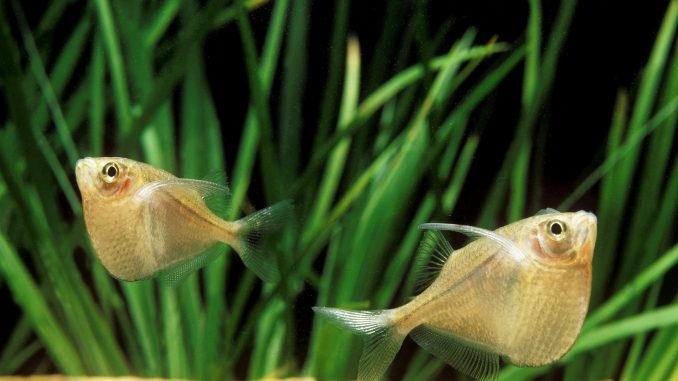
The unique Hatchetfish, named so because its triangular profile looks like a hatchet, is an exciting choice for a home aquarium. You’ll enjoy watching these little ones darting back and forth across your tank: they are excellent swimmers who skillfully maneuver their way through the water.
They are fast predators, too, able to turn with ninja accuracy to capture their prey. While they will not take flight in your home aquarium, in the wild they use their wing-like fins to fly up and catch insects.
Read on to find out everything you need to know about keeping and caring for the four most common types of hatchetfish found in the aquarium hobby. We will cover history and origins, behavior and appearance, tank conditions, and more.
TABLE OF CONTENTS
Hatchetfish Facts & Overview
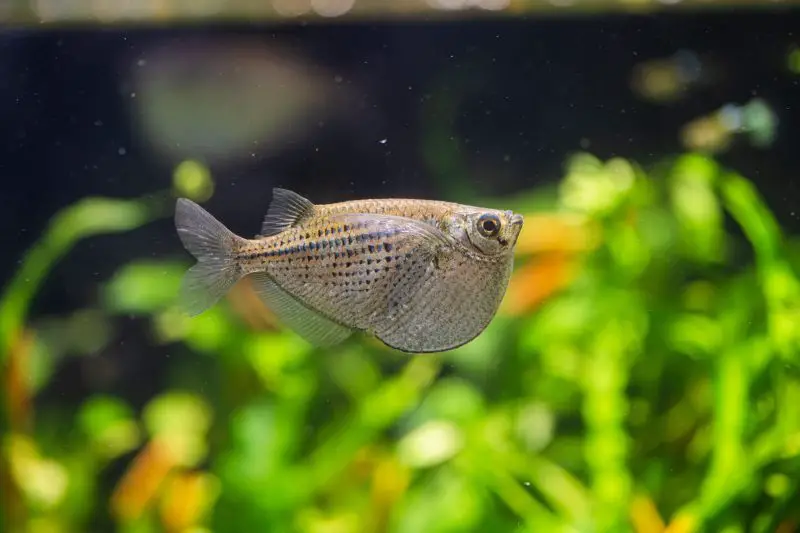
| Category | Rating |
| Care Level: | Difficult |
| Temperament: | Peaceful |
| Color Form: | Varies by species |
| Lifespan: | 2-5 years |
| Size: | 1.5 inches |
| Diet: | Carnivore |
| Family: | Gasteropelecidae |
| Minimum Tank Size: | 15 gallons |
| Tank Set-Up: | Freshwater with floating plants and rocks |
| Compatibility: | Peaceful but predatory |
Hatchetfish, which belong to 9 different species across 3 genera, are native to rivers and swamps in Central and South America. They can be found in headwaters, pools, and tributaries around these rivers and swamps.
Their stiff fins and hatchet shape lend themselves to stellar swimming and predatory capabilities. They stay near the surface of the water pretty much all the time, even when they breed. In the wild, hatchetfish are capable of flying more than 4 feet. In your home aquarium, they are likely to try to jump out.
Four species of the family Gasteropelecidae are common in the aquarium hobby, and we will go into specific details about each one. One confusing bit is that two species, Gasteropelecus levis and Gasteropelecus sternicla, are both often referred to as Silver Hatchetfish, but that is a misnomer for Gasteropelecus sternicla, which are actually Common Hatchetfish.
Throughout this article, Silver Hatchetfish refers to Gasteropelecus levis and Common Hatchetfish refers to Gasteropelecus sternicla.
Additionally, we will cover Marbled Hatchetfish (Carnegiella strigata) and Blackwing Hatchetfish (Carnegiella marthae).
Silver Hatchetfish
Found in the wild in Brazil, Silver Hatchetfish (Gasteropelecus levis) live in the Amazon River basin, in canals, streams, and other waterways. During the rainy season, they will also pop up in floodplain lakes.
This Hatchetfish specimen is the shyest of all the Hatchetfish we are exploring. It is slightly smaller than the Common Hatchetfish (one way you can distinguish between the two even when the Common Hatchetfish is marketed as a Silver Hatchetfish), and larger than the Marbled and Blackwing Hatchetfish.
Fully grown Silver Hatchetfish are 2 to 2¼ inches (5.08 to 5.72 cm) and have a life expectancy of about 3 years in captivity.
Typical Behavior
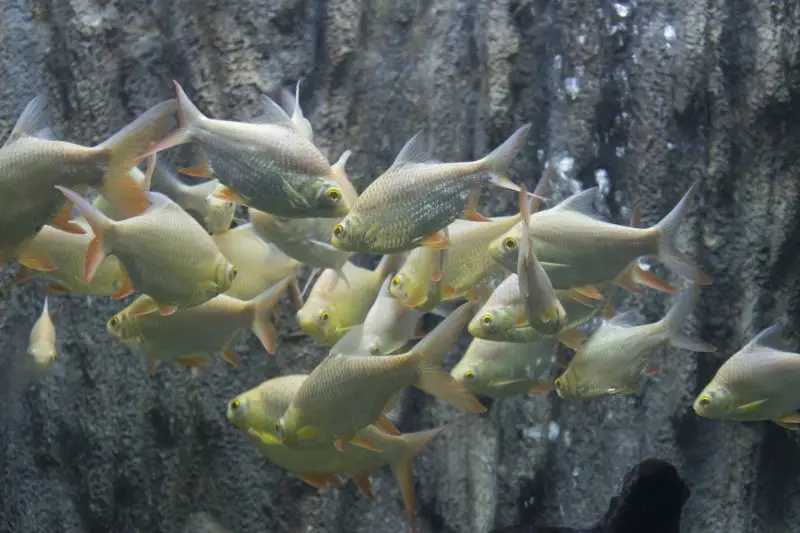
Because they are so shy, Silver Hatchetfish will look for places to hide. In the wild, they hide in the roots of floating plants, so if you can recreate this environment in your home tank, your Silver Hatchetfish will be happy, indeed. They will be scared of other active fish and will be stressed if they don’t have places to seek refuge.
Silver Hatchetfish are not the biggest jumpers of the aquarium hobby Hatchetfish, but it is in their nature, so best to have a tight-fitting lid for all Hatchetfish species.
Appearance
Silver Hatchetfish are fairly small and grow to a size of about 2 to 2¼ inches (5.08 to 5.72 cm). Their bodies are metallic silver and they have stripes that are bronze and black. They get their name from their body color and their compressed body shape, which looks like the head of a hatchet.
Differentiating between males and females
Like many other fish species, the female Silver Hatchetfish are rounder–they are designed to carry eggs around, after all.
Habitat and Tank Conditions
Silver Hatchetfish are sensitive to ammonia, so it’s best to add them to an established tank in which stable parameters have already been established.
Because they live near the water’s surface and because they are very shy, it’s best to keep floating plants well-stocked in their aquarium. This gives them places to seek refuge, and since they are not bottom dwellers, planted greens will be ineffective for Silver Hatchetfish.
Additionally, by providing them with similar conditions to their native environments, Silver Hatchetfish will be less stressed out and more likely to thrive.
Water Conditions
Just as Silver Hatchetfish are sensitive to ammonia, they are at risk from any changes in water parameters, including pH. Therefore, it’s necessary to have a strong filter and to keep your tank clean.
It’s also important to remember that fluctuations even within the acceptable range can be harmful to Silver Hatchetfish, so maintain the same levels for best fish health.
The optimal parameters to ensure a close match to the natural habitat of the Silver Hatchetfish are:
- pH levels: 5.8 to 6.9
- Water hardness: 2 to 12 dKH
- Water temperature: 74°F to 83°F (23.3-28.3°C)
What Size Aquarium Do They Need?
You’ll need at least a 20-gallon tank for your Silver Hatchetfish, as they should be housed together in groups of at least 6.
Tank Mates
Although we see them thrive in tanks that are dedicated to only Silver Hatchetfish, you could place them in a community tank with bottom dwellers since Silver Hatchetfish spend the bulk of their time in the upper part of the tank.
You also want to make sure that any other fish you put in the tank with Silver Hatchetfish are peaceful–any aggressive or super active fish are just going to stress out the Silver Hatchetfish.
Additionally, pairing them with more aggressive fish will threaten the food supply of the Silver Hatchetfish.
Suitable Tankmates
- Bristlenose Plecos
- Corydoras
- Cichlids
- Loricariids
- Tetras
Keeping Silver Hatchetfish Together
Six is the smallest group of Silver Hatchetfish that we advise. These fish do better when they are in a larger group. You definitely do not want to keep singles–they will not thrive.
Diet
Silver Hatchetfish are carnivores and will appreciate floating sources of protein. You can provide meaty foods that are frozen, freeze-dried, or live, such as blackworms, bloodworms, brine shrimp, daphnia, mosquito larvae, fruit flies, and tubifex. They will also accept flake food.
In the wild, 90 percent of their diet comes from insects, so offering these foods to your Silver Hatchetfish will make them happy and reduce their stress.
Care
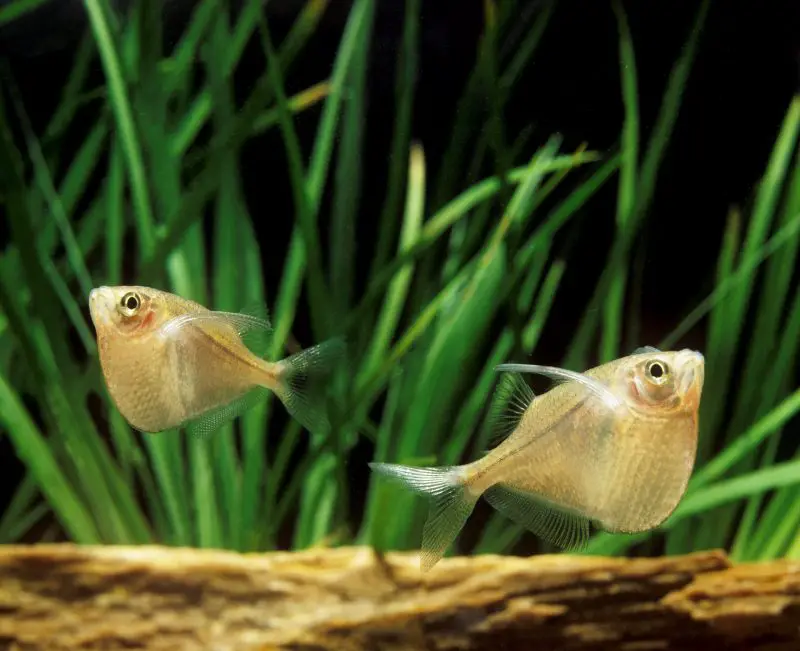
Keeping a clean tank with proper water parameters is imperative for providing the best care for your Silver Hatchetfish. If their water is too alkaline, they are more susceptible to disease. For example, they are prone to ich, caused by a parasitic infection and identifiable by white spots on your fish.
In addition, excessive stress also compromises their immune system and makes them more likely to get sick, so providing a peaceful environment for Silver Hatchetfish is important. You’ll notice a decrease in activity and loss of color vibrancy when they are under a lot of stress.
Breeding
Silver Hatchetfish deposit their eggs on floating plants, but beyond that, not much is known about their breeding habits. There have been some reports that soft water with a lower pH and a diet rich in insects encourage spawning.
However, due to the lack of confirmed breeding information, we do not recommend attempting to breed these silver beauties.
Common Hatchetfish
As we mentioned, the Common Hatchetfish (Gasteropelecus sternicla) are often sold as Silver Hatchetfish, but they are actually a distinct species from the Silver Hatchetfish Gasteropelecus levis.
Although there are many similarities between these two species, the Common Hatchetfish is distinguishable from the Silver Hatchetfish in both appearance and behavior. The Common Hatchetfish is larger than the Silver Hatchetfish, reaching a size of about 2.5 inches (6.5 cm). In addition to being larger, they are less timid than the Silver Hatchetfish.
The Common Hatchetfish is found in the central basin of the Amazon River, to the north in Venezuela, and to the west in Peru. They can also be found in Guyana and Suriname.
The Common Hatchetfish is also sometimes known as the River Hatchetfish due to its native location.
Typical Behavior
The Common Hatchetfish is not a very active fish; in fact, it is the least active of the Hatchetfish. They passively stalk their prey rather than chasing after it, perhaps because they have excellent eyesight and capture their meals with precision.
Like the Silver Hatchetfish, Common Hatchetfish also fall under the category of flying fish, for they use their strong chest fins to help them “fly” to catch insects. This skill is true of all the Gateropelecidae hatchetfish.
Common Hatchetfish are more likely to jump than Silver Hatchetfish, so make sure you have that tight-fitting lid. These hatchetfish have a lifespan of 2 to 5 years.
Appearance
The Common Hatchetfish has a sleeker body with a substantial belly and those flight-assisting pectoral fins are located higher up on their body. Their mouths turn up, similar to other surface habitants, and are located close to the top of their heads.
Like Silver Hatchetfish, Common Hatchetfish have a silver body (perhaps where the misnomer comes in) and a prominent black stripe. As I mentioned before, the Common Hatchetfish are a little larger, averaging about 2.5 inches (6.5 cm), although there are some reports of Common Hatchetfish reaching 3 inches (7.6 cm).
Habitat and Tank Conditions
The main requirement for Common Hatchetfish is a clean tank, so you’ll need a decent filter. In addition to regular cycled water changes, regular testing of water conditions is recommended. These fish do better when they are offered stable water parameters.
Biweekly water changes of 25 to 50% are recommended, particularly if you have a densely planted tank.
Like Silver Hatchetfish, Common Hatchetfish prefer an aquascape of floating plants where they can lay low while they are waiting for their prey to float (or fly) by. Although they appreciate the plants, make sure to leave them some space for feeding.
Common Hatchetfish also exist primarily at the water’s surface, making floating plants the best option.
Common Hatchetfish do well with moderate to normal lighting conditions, so you don’t really need to do anything special in terms of extra lights.
Water Conditions
Soft water is best for Common Hatchetfish, as it most closely matches the water conditions in the Amazon waters. They also prefer slightly acidic water; like the Silver Hatchetfish, they don’t do well in water that has too much ammonia.
The optimal parameters to ensure a close match to their natural habitat are:
- pH levels: 6.0 to 6.8
- Water hardness: 2 to 14 dKH
- Water temperature: 72°F to 79°F (22.2-26.1°C)
What Size Aquarium Do They Need?
A 15-gallon tank is the minimum recommended size for Common Hatchetfish.
Tank Mates
The peaceful Common Hatchetfish makes a better community tank mate than Silver Hatchetfish since the Common is not as shy as the Silver, so they won’t get stressed out by having other species sharing their space.
Nonetheless, avoid aggressive fish that might threaten Common Hatchetfish or steal their food. For example, adding Characins to a tank with Common Hatchetfish will pretty much ensure that the Common Hatchetfish won’t have enough food.
Suitable Tankmates
- Corydoras
- Crab
- Dwarf Cichlids
- Loricariids
- Shrimp
- Snails
- Tetras
Keeping Common Hatchetfish Together
It is far better to keep Common Hatchetfish together. They are more likely to thrive and to be active and happy if they are kept in a group. Eight or more is a good size group to aim for.
Diet
Diet is another area in which you’ll find similarities between the Common Hatchetfish and Silver Hatchetfish. In the wild, these carnivores eat crustaceans and insects, including mosquito larvae and vinegar flies. In captivity, they will accept flake, fresh, and live food on the surface of the water.
Variety is key, and you should offer alternating proteins, such as blood worms, brine shrimp, fruit flies, and pinhead crickets.
You should feed them several times a day, making sure they don’t overeat. It’s advisable to turn off the filter when you feed them so that their food does not sink to the bottom before they can eat it.
Care
Common Hatchetfish are susceptible to the same diseases as Silver Hatchetfish. It’s vital to maintain a clean tank, check water parameters regularly, and keep them stress-free. They also have a tendency to get the parasitic ich.
As with all fish, if you are introducing them into an established aquarium, it is important to quarantine them before adding them to the tank. Conversely, any new plants, fish, or decorations should be quarantined before introducing them to your already established hatchetfish.
Breeding
No one has successfully bred Common Hatchetfish in captivity. We know that they are egg layers, but we don’t recommend trying to breed at home.
Marbled Hatchetfish
The Marbled Hatchetfish (Carnegiella strigata), is ironically the most common hatchetfish in the aquarium hobby–yes, more common than the Common Hatchetfish. The Marbled Hatchetfish is significantly smaller than the Common Hatchetfish, and won’t get much larger than 1.75 inches (4.4 cm).
Additionally, Marbled Hatchetfish unfortunately will not be with you for very long–they have a lifespan of only about 2 years.
Typical Behavior
Despite (or perhaps because of) its small size, Marbled Hatchetfish are the best jumpers of all the hatchetfish. These tiny specimens have the ability to jump more than 5 feet high or forward, quite a feat considering the fish is less than 2 inches long.
The bulk of their body weight, in fact, comes from their unusually large pectoral fins, which are what allows them to jump as high and as far as they do.
Appearance
The Marbled Hatchetfish, as its name implies, is quite a treat to behold, with an iridescent and black marbled body with bronze stripes.
They have big eyes and the same upturned mouth as the other hatchetfish, allowing them to grab prey from the water’s surface.
Habitat and Tank Conditions
Start with a 20-gallon tank since Marbled Hatchetfish need more room to both feed and swim around. You can use floating plants as with the other hatchetfish, but these fish can also be happy with taller plants that are similar to grass and whose leaves extend to the water column.
Remember that hatchetfish use the dangling roots from floating plants as hiding places, and Marbled Hatchetfish are no exception. However, Marbled Hatchetfish are more active swimmers and need enough space to swim around.
Water Conditions
Honoring the proper water parameters is paramount since they are extremely sensitive to changes in conditions. Perform regular water tests and perform 50% water changes every two weeks. Remember that hatchetfish do not do well in overly alkaline water and require more acidic water.
The optimal parameters to ensure a close match to their natural habitat are:
- pH levels: 5.6 to 6.5
- Water hardness: 2 to 12 dKH
- Water temperature: 74°F to 80°F (23.3-26.7°C)
What Size Aquarium Do They Need?
We recommend a 20-gallon tank to accommodate a small school and give them plenty of space to swim around freely.
Tank Mates
Peaceful like other hatchetfish, the Marbled Hatchetfish makes a great tank mate for any community aquarium, assuming the fish that you are planning to pair it with share the same acceptable water parameters.
The one caveat is that you should choose tank mates that do not occupy the top of the water column–Marbled Hatchetfish do not like to share. You should also avoid mixing them with active and energetic fish, which would stress them out.
Keep them away from other species of hatchetfish, betta fish, tiger barbs, and danios.
Keeping Marbled Hatchetfish Together
Some enthusiasts keep their Marbled Hatchetfish in schools like other hatchetfish we have discussed. But you should know that Marbled Hatchetfish are more territorial than other hatchets and can get aggressive with other Marble Hatchetfish.
Diet
Like other hatchetfish, Marbled Hatchetfish are carnivores and need a steady diet of meaty proteins. Offer a variety of bloodworms, fruit flies, tubifex, and protein flakes.
Care
With a significantly shorter lifespan than the other aquarium hobby hatchetfish, Marbled Hatchetfish need diligent care so that they can have the best quality of life possible.
Marbled Hatchetfish are in danger of contracting the same diseases as other aquarium fish, such as ich and other parasitic infections, as well as bacterial infections. Keeping a clean tank prevents these kinds of maladies, as does avoiding stress.
The best ways to limit stress in your Marbled Hatchetfish are:
- Keeping the tank clean
- Providing them with hiding spots
- Recreating their natural habitat and diet
- Protecting them by keeping aggressive and overly active fish out of the tank
Breeding
Unlike the Silver and Common Hatchetfish, Marbled Hatchetfish have been bred in captivity. You will need a separate breeding tank with soft and mildly acidic water. After a lengthy period of “dating,” the female will spread her eggs on roots and plants in the tank.
After the eggs have been fertilized, you should remove the male and female so that they don’t eat the eggs or the fry, which hatch within 2 days.
Blackwing Hatchetfish
Our last hatchetfish in the aquarium hobby is the Blackwing Hatchetfish (Carnegiella marthae). Blackwing Hatchetfish are the smallest of the bunch and only grow to about 1.25 inches (3.2 cm).
Blackwing Hatchetfish are found in Venezuela and Colombia enjoying still waters and lush vegetation in their natural habitat, so they will prefer more cover of floating aquatic plants than the Marbled Hatchetfish. They are not as active and therefore do not require the same amount of open space for swimming.
Typical Behavior
Blackwing Hatchetfish are the timidest of the four aquarium hobby hatchetfish, which is why they prefer plentiful refuge spots. They are easily stressed out and should be kept away from rowdy tankmates. They are even agitated by outside activity, so be mindful of where you keep your tank.
They are also less likely to jump than the other hatchetfish, but should still have a tight-fitting lid on their tank to prevent any possible flying out of the tank.
Appearance
Blackwing Hatchetfish has a black back and pectoral fins, which is how they get their name. They have the same hatchet-shaped body that all the hatchetfish do, with an upturned mouth that is located at the top of the head for easy surface feeding.
The bottom of their bodies are bright silver and they get darker in hue higher up on the body.
Habitat and Tank Conditions
Blackwing Hatchetfish will feel safer and less stressed with lower lighting and a darker substrate. If you have lots of floating plants, the plants will filter out some light as well as give them hiding spots in the long roots draping down.
Water Conditions
Water conditions for this species are similar to other hatchetfish. They, too, are sensitive to alkaline water.
The optimal parameters to ensure a close match to their natural habitat are:
- pH levels: 5.8 to 6.9
- Water hardness: 2 to 12 dKH
- Water temperature: 74°F to 83°F (23.3-28.3°C)
What Size Aquarium Do They Need?
We recommend at least a 15-gallon tank for the Blackwing Hatchetfish.
Tank Mates
Blackwing Hatchetfish do well in a community tank and are also not as territorial with other hatchetfish as the Marbled Hatchetfish are. Be sure to keep them with other peaceful fish since they get stressed so easily by fish that are aggressive and highly active.
Suitable Tank Mates for Blackwing Hatchetfish:
- Callichthys Catfish
- Loricariid Catfish
- Peaceful Characids
Keeping Blackwing Hatchetfish Together
Blackwing Hatchetfish does best in a group of at least six. They should not be kept as singles.
Diet
Blackwing Hatchetfish love insects. Their protein diet should consist of a variety of choices, including Bloodworms, brine shrimp, crickets, daphnia, fruit flies, and tubifex. They will also accept flakes. You should provide a combination of dried, frozen, and live food.
Care
Care is similar to other hatchetfish. Keep their tank clean and their lives free of stress, and they will thrive during their 4-year lifespan.
Breeding
There are no reports of successful breeding in captivity of Blackwing Hatchetfish and I do not recommend attempting to breed at home.
Are Hatchetfish Suitable for your Aquarium?
Each species of hatchetfish is unique and they are all super fun to look at, with their rounded bodies that resemble hatchets and their upturned mouths situated on top of their head. I never get tired of looking at these little creatures. It’s enjoyable to watch them swimming around in their school and also catching their prey.
I think you’ll enjoy having a group of hatchetfish in your community tank.
What is your favorite species of hatchetfish? Let us know in the comments below…

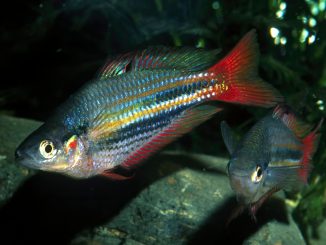
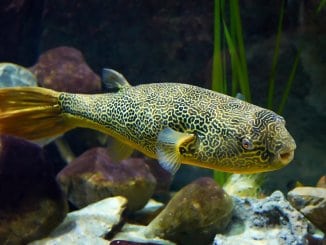
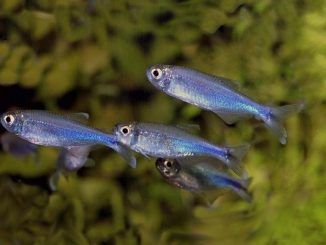
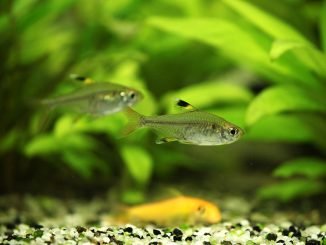
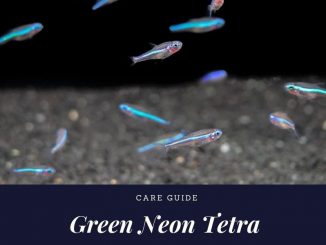
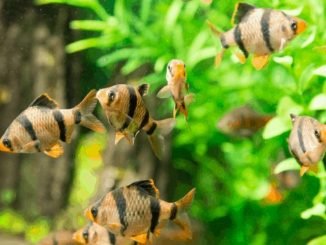

My favorite hatchetfish are the black winged hatchetfish as I love flying fishs fins and black winged hatchetfish fins stand out the most I got them after looking at the variety for sale and the only one I hadnt seen or heard of before were the black winged hatchetfish and the giant ones too but I prefer teeny tiny fish I was told theyre a bit more rare after reading this I know why Im am very happy with my little ones they werent very active so I looked up stuff about them and now now I know thats normal I got 6 but 1 died the day after acclimation so now Im left at 5 since I refuse to get a refundafter fish die in my tank (Idont support warrantiesits normallythe owners fault it wasnt my hatchetfishare just fragile during the first few weeks and nothing was wrong with my water but I still refuse Ill get 4 or 5 more soon though I absolutely love them but I was buying other fish as well and didnt wanna shock my system with too many at once